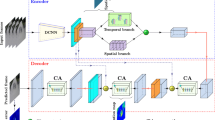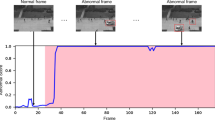Abstract
The common use of video cameras in public and private spaces for traffic management, security, and anomaly detection has brought significant benefits. However, automatically detecting anomalous activity within this vast amount of video data offers a significant challenge. Existing video anomaly detection algorithms have limitations such as high computational cost, low performance, and a large demand for specific hardware resources. To overcome these drawbacks, this paper introduces a novel autoencoder model for accurate anomaly detection. First, the University of Central Florida (UCF) crime dataset is used to collect input data. Input videos are transformed into frames; then, keyframes are chosen from the Cosine Similarity distance measure. Selected keyframes are fed into the pre-processing stage to improve the brightness-guided pre-processing procedure for enhancing the brightness variability of keyframes. Optimal features from the pre-processed frames were taken using the chaotic gazelle optimization algorithm (CGOA) to reduce training time. Finally, residual channel attention assisted spatial–temporal autoencoder (RCAA-STAE) in detecting anomaly classes. The performance of the proposed model is estimated and compared with previous studies. The proposed model attained effective performance results in terms of accuracy, precision, recall, specificity, kappa, Root mean square error (RMSE), area under the curve (AUC), and mean square error (MSE). Accuracy performance attained by the proposed approach is 99.23% and 99.5% for normal and abnormal classes using the UCF-crime dataset.








Similar content being viewed by others
Data availability
Data sharing is not applicable to this article.
References
Patrikar, D.R., Parate, M.R.: Anomaly detection using edge computing in video surveillance system. Int. J. Multimed. Inf. Retr. 11(2), 85–110 (2022)
Zhang, M., Wang, J., Qi, Q., Sun, H., Zhuang, Z., Ren, P., ... & Liao, J.: Multi-scale video anomaly detection by multi-grained spatio-temporal representation learning. In Proceedings of the IEEE/CVF Conference on Computer Vision and Pattern Recognition 17385–17394 (2024).
Caetano, F., Carvalho, P., Cardoso, J.: Deep anomaly detection for in-vehicle monitoring—an application-oriented review. Appl. Sci. 12(19), 10011 (2022)
Shao, W., Xiao, R., Rajapaksha, P., Wang, M., Crespi, N., Luo, Z., Minerva, R.: Video anomaly detection with NTCN-ML: A novel TCN for multi-instance learning. Pattern Recogn. 143, 109765 (2023)
Chandrakala, S., Deepak, K., Revathy, G.: Anomaly detection in surveillance videos: A thematic taxonomy of deep models, review and performance analysis. Artif. Intell. Rev. 56(4), 3319–3368 (2023)
Züfle, M., Moog, F., Lesch, V., Krupitzer, C., Kounev, S.: A machine learning-based workflow for automatic detection of anomalies in machine tools. ISA Trans. 125, 445–458 (2022)
Affonso, G. A., De Menezes, A. L., Nunes, R. B., & Almonfrey, D.: Using artificial intelligence for anomaly detection using security cameras. In 2021 International Conference on Electrical, Computer, Communications and Mechatronics Engineering (ICECCME), 1–5 (2021). IEEE.
Rezaee, K., Rezakhani, S.M., Khosravi, M.R., Moghimi, M.K.: A survey on deep learning-based real-time crowd anomaly detection for secure distributed video surveillance. Pers. Ubiquit. Comput. 28(1), 135–151 (2024)
Nassif, A.B., Talib, M.A., Nasir, Q., Dakalbab, F.M.: Machine learning for anomaly detection: A systematic review. Ieee Access 9, 78658–78700 (2021)
Wang, S., Wang, X., Zhang, L., Zhong, Y.: Auto-AD: autonomous hyperspectral anomaly detection network based on fully convolutional autoencoder. IEEE Trans. Geosci. Remote Sens. 60, 1–14 (2021)
Thomas, A.L., Piza, E.L., Welsh, B.C., Farrington, D.P.: The internationalisation of cctv surveillance: Effects on crime and implications for emerging technologies. Int. J. Comp. Appl. Crim. Just. 46(1), 81–102 (2022)
Elmetwally, A., Eldeeb, R., Elmougy, S.: Deep learning based anomaly detection in real-time video. Multimed. Tools Appl. (2024). https://doi.org/10.1007/s11042-024-19116-9
Tian, Y., Pang, G., Chen, Y., Singh, R., Verjans, J. W., & Carneiro, G.: Weakly-supervised video anomaly detection with robust temporal feature magnitude learning. In Proceedings of the IEEE/CVF International Conference on Computer Vision, 4975–4986 (2021).
Liu, Z., Nie, Y., Long, C., Zhang, Q., & Li, G.: A hybrid video anomaly detection framework via memory-augmented flow reconstruction and flow-guided frame prediction. In Proceedings of the IEEE/CVF International Conference on Computer Vision, 13588–13597 (2021).
Liu, Y., Liu, J., Lin, J., Zhao, M., Song, L.: Appearance-motion united auto-encoder framework for video anomaly detection. IEEE Trans. Circuits Syst. II Express Briefs 69(5), 2498–2502 (2022)
Deepak, K., Chandrakala, S., Mohan, C.K.: Residual spatiotemporal autoencoder for unsupervised video anomaly detection. SIViP 15(1), 215–222 (2021)
Wang, G., Wang, Y., Qin, J., Zhang, D., Bao, X., & Huang, D.: Video anomaly detection by solving decoupled spatio-temporal jigsaw puzzles. In European Conference on Computer Vision, 494–511 (2022). Cham: Springer Nature Switzerland.
Chen, Y., Liu, Z., Zhang, B., Fok, W., Qi, X., Wu, Y.C.: Mgfn: Magnitude-contrastive glance-and-focus network for weakly-supervised video anomaly detection. Proc. AAAI Confer. Artif. Intell. 37(1), 387–395 (2023)
Wan, B., Jiang, W., Fang, Y., Luo, Z., Ding, G.: Anomaly detection in video sequences: A benchmark and computational model. IET Image Proc. 15(14), 3454–3465 (2021)
Cho, M., Kim, T., Kim, W.J., Cho, S., Lee, S.: Unsupervised video anomaly detection via normalizing flows with implicit latent features. Pattern Recogn. 129, 108703 (2022)
Qasim, M., Verdu, E.: Video anomaly detection system using deep convolutional and recurrent models. Res. Eng. 18, 101026 (2023)
Wu, C., Shao, S., Tunc, C., Satam, P., & Hariri, S.: An explainable and efficient deep learning framework for video anomaly detection. Cluster computing, 1–23 (2022).
Khan, S.W., Hafeez, Q., Khalid, M.I., Alroobaea, R., Hussain, S., Iqbal, J., Ullah, S.S.: Anomaly detection in traffic surveillance videos using deep learning. Sensors 22(17), 6563 (2022)
Ul Amin, S., Kim, Y., Sami, I., Park, S., Seo, S.: An efficient attention-based strategy for anomaly detection in surveillance video. Comput. Syst. Sci. Eng. 46(3), 3939–3958 (2023)
Liu, Y., Liu, J., Zhao, M., Yang, D., Zhu, X., & Song, L.: Learning appearance-motion normality for video anomaly detection. In 2022 IEEE International Conference on Multimedia and Expo (ICME), 1–6 (2022). IEEE.
Le, V.T., Kim, Y.G.: Attention-based residual autoencoder for video anomaly detection. Appl. Intell. 53(3), 3240–3254 (2023)
Vosta, S., Yow, K.C.: A cnn-rnn combined structure for real-world violence detection in surveillance cameras. Appl. Sci. 12(3), 1021 (2022)
Castillo, A., Tabik, S., Pérez, F., Olmos, R., Herrera, F.: Brightness guided pre-processing for automatic cold steel weapon detection in surveillance videos with deep learning. Neurocomputing 330, 151–161 (2019)
Agushaka, J.O., Ezugwu, A.E., Abualigah, L.: Gazelle optimization algorithm: a novel nature-inspired metaheuristic optimizer. Neural Comput. Appl. 35(5), 4099–4131 (2023)
DAS, S., Rao, K. S., Gopal, H. P., & Reddy, L. K.: The crime data analysis using machine learning. Spast abstracts, 1(01), (2021).
Babiyola, A., Aruna, S., Sumithra, S., Buvaneswari, B.: A hybrid learning frame work for recognition abnormal events intended from surveillance videos. J. Intell Fuzzy Syst. 45(1), 1089–1102 (2023)
Qasim Gandapur, M., & Verdú, E.: ConvGRU-CNN: Spatiotemporal deep learning for real-world anomaly detection in video surveillance system. (2023).
Patwal, A., Diwakar, M., Tripathi, V., Singh, P.: An investigation of videos for abnormal behavior detection. Proc. Comput. Sci. 218, 2264–2272 (2023)
Quintero, R. F., & Benitez-Restrepo, H. D.: Anomaly detection in surveillance videos using spatio-temporal context information.
Karim, H., Doshi, K., & Yilmaz, Y.: Real-time weakly supervised video anomaly detection. In Proceedings of the IEEE/CVF winter conference on applications of computer vision, 6848–6856 (2024).
Liang, W., Zhang, J., Zhan, Y.: Weakly supervised video anomaly detection based on spatial–temporal feature fusion enhancement. SIViP 18(2), 1111–1118 (2024)
Asal, B., Can, A.B.: Ensemble-based knowledge distillation for video anomaly detection. Appl. Sci. 14(3), 1032 (2024)
Mumtaz, A., Sargano, A.B., Habib, Z.: AnomalyNet: A spatiotemporal motion-aware CNN approach for detecting anomalies in real-world autonomous surveillance. Vis. Comput. 40(11), 7823–7844 (2024)
Li, C., Chen, M.: Dy-MIL: dynamic multiple-instance learning framework for video anomaly detection. Multimed. Syst. 30(1), 11 (2024)
Basak, S., Gautam, A.: Diffusion-based normality pre-training for weakly supervised video anomaly detection. Expert Syst. Appl. 251, 124013 (2024)
Adel, R., Youssif, A., & Mostafa, M.: Transfer learning model for anomalous event recognition in big video data. (2024).
Funding
No funding is provided for the preparation of the manuscript.
Author information
Authors and Affiliations
Contributions
"1M.Lakshmi Prasudha Review and Editing Preparation, Software, Formal analysis, Investigation, *2 Vidyullatha Sukhavasi Supervision, Project administration, Specifically Writing the Initial Draft, Resources. 3Kandula Neha Specifically Critical Review, Visualization, Methodology, Commentary. 4Poonam Shaylesh Lunawat Conceptualization, Writing–Original Draft Preparation, Data Curation, Validation.All authors reviewed the manuscript."
Corresponding author
Ethics declarations
Conflict of interest
Authors declare that they have no conflict of interest.
Ethical approval
This article does not contain any studies with human participants or animals performed by any of the authors.
Consent to participate
All the authors involved have agreed to participate in this submitted article.
Consent to Publish
All the authors involved in this manuscript give full consent for publication of this submitted article.
Additional information
Publisher's Note
Springer Nature remains neutral with regard to jurisdictional claims in published maps and institutional affiliations.
Rights and permissions
Springer Nature or its licensor (e.g. a society or other partner) holds exclusive rights to this article under a publishing agreement with the author(s) or other rightsholder(s); author self-archiving of the accepted manuscript version of this article is solely governed by the terms of such publishing agreement and applicable law.
About this article
Cite this article
Prasudha, M.L., Sukhavasi, V., Neha, K. et al. Feature selection algorithm assisted residual channel attention spatio-temporal auto encoder for video anomaly detection. SIViP 19, 148 (2025). https://doi.org/10.1007/s11760-024-03640-0
Received:
Revised:
Accepted:
Published:
DOI: https://doi.org/10.1007/s11760-024-03640-0




